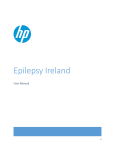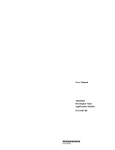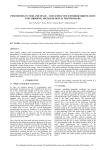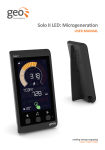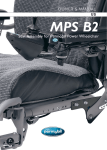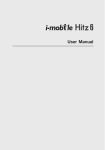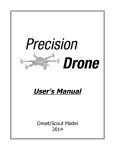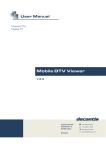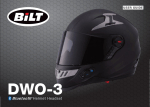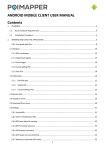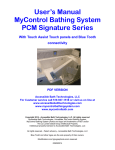Download SoloStorm User Guide - Petrel Data Systems
Transcript
SoloStorm User Guide Prerequisites Install an SD Memory Card Pair Bluetooth Devices Allow non-market applications Install SoloStorm Install the SoloStorm .apk file Unlock SoloStorm Quick Start Guide - Basic Settings Select Bluetooth Devices Bluetooth GPS Bluetooth OBDII Set Event and Driver Name Set session name Set driver names Select Driver Calibrate Accelerometer Start Logging Run Analysis Load a run log Run Navigation/Playback In-App Help Advanced Settings/Instructions Main / Logging Screen Main Screen Widgets Session/Driver Widget Logger Status Widget Accelerometer + OBD2 Telemetry Widget Manual Start/Stop & Start/Stop Video Button Main Screen Menu Buttons * Analyze Analysis Menu Log Management Analysis Widgets Markers Setting Markers Clearing Markers Settings *GPS *OBD-II *Video *Triggers Set Automatic Start/Stop Triggers *Log Files *Display *Help *License *Device Information Advanced Logger Instructions Accelerometer Satellite readings Advanced Analysis Instructions Math Channel Options Traces Trace Selection & Display How to read Traces Available Traces Section Analysis Section Data *Edit Sections Video Options *Share *Play Video Jogging Overlay Video Prerequisites Install an SD Memory Card It is highly suggested that you install extra memory on your Android device to ensure you have enough memory to cover your datalogging needs prior to installing and using SoloStorm. Data logging is storage intensive, particularly if you are recording video with your device. Processing video is greatly optimized by making use of a highquality, Class 10 flash memory card from a reputable manufacturer, as it will support higher read and write speeds than a generic version. A 16GB or 32GB card is recommended. Please refer to the user manual for your Android device to determine how to install the external memory card. Configuring SoloStorm to make use of the added memory will be covered in a later step. Pair Bluetooth Devices Please follow the documentation that comes with your Android device in order to it with Bluetooth GPS and OBD-II modules prior to installing SoloStorm. While most devices will allow you to pair Bluetooth devices on the fly, doing so before starting the application will ensure a trouble-free configuration process. When pairing Blutooth devices, a PIN code is usually required. If the instructions for the Bluetooth module do not specify a PIN, try ‘1234’ or ‘0000’. Qstarz GPS units use ‘1234’. Please note that Android devices prior to v2.3 (Gingerbread) do not support simultaneous operation of Bluetooth devices. If you are running Android v2.2, then upgrade your operating system if possible. If not, then you can not use both an external GPS and an OBD-II reader. Selecting your GPS and OBD-II devices will be covered in a later step. Allow non-market applications SoloStorm is not an application sourced through the Google Market. By default your device is set to NOT allow this type of application. This setting needs to be changed for you to install SoloStorm on your Android device. 1. Open the Settings Applications menu on your Android device. 2. Ensure that the option for Unknown Sources is CHECKED. Install SoloStorm Install the SoloStorm .apk file After ordering SoloStorm, you will be prompted to download the SoloStorm application .apk file. You will also receive an email containing an unlock code to enable SoloStorm’s logging functionality. If you are downloading the .apk file directly to your device, you may be prompted to install it (this depends on your device, as some do not recognize downloaded applications). If you have downloaded the .apk file to a PC, email it to the gmail account that you have registered on your device. On most Android devices, the Gmail application will recognize the .apk file and allow you to install directly from your e-mail. There will be an “Install” button next to the attachment, tap it to start the install process. Tip: If you are having trouble installing SoloStorm and receive a message similar to ‘error parsing package’, then you must download and install the free ApKatcher application from Google Play (formerly the Android Marketplace). This will allow your device to recognize downloaded .apk files. You can read more at https://play.google.com/store/apps/details? id=nEx.software.Apps.APKatcher&hl=en During installation, you will be prompted to grant a number of permissions to SoloStorm. SoloStorm requires access to many features on the Android device, so this list of permissions is quite long. Unlock SoloStorm SoloStorm does not require a license in order to open and analyze logs, however one is required in order to log data and record video. You may unlock SoloStorm on as many devices as you wish, so long as the email address associated with your license and unlock code is registered on the device. Note that some email clients do not register the email address with the device and only store it in private memory. In order to be safe, it is best to use a Gmail address, which is registered globally on the device. Perform these steps on the Android device you wish to install on. 1. Open the e-mail containing the unlock code. 2. Highlight and copy the unlock code or write it down. 3. Open SoloStorm 4. Tap the box to start the licensing process Quick Start Guide - Basic Settings SoloStorm now has a first-time help feature that will guide you through basic first time setup. If you do not receive this prompt, you can turn it on by going to Reset Tool Tips: Settings Help Select Bluetooth Devices This section describes how to enable Bluetooth devices for logging. NOTE: Your Bluetooth devices should be already paired with your Android device, please refer to your respective user manuals to complete this. Bluetooth GPS NOTE: it is best to have Bluetooth already turned on and your GPS bluetooth device must be already paired 1. From the main screen, tap Bluetooth Settings GPS 2. If prompted, tap Yes to allow Bluetooth to be turned on. 3. You will be given a list of all available Bluetooth devices. Tap on your Bluetooth GPS device name and address to use it with SoloStorm. 4. Touch Back to exit once your device is set. Bluetooth OBDII 1. From the main screen, tap Bluetooth ELM 327 Settings OBD-II 2. If prompted, tap Yes to allow Bluetooth to be turned on on your device. 3. You will be given a list of all available Bluetooth devices. Tap on your Bluetooth GPS device name and address to use it with SoloStorm. Set Event and Driver Name This function allows you to organize your data according to sessions and drivers. Tap the Driver Info box on the main screen to enter Driver/Session data. Set session name Type the name of the current race, event or session name you want to record the data under in the Session Name box. This name will be used for all drivers until you change it. Session names must contain only Alphanumeric characters. Set driver names Type a driver name in the Add New Driver box, touch the Add button once completed. The new driver name will appear in the list below. Each driver has a checkbox next to their name indicating whether the Driver is selectable from the main screen. Drivers that are not checked will not be rotated through or appear on the driver selection list in the main logging screen. This is useful to set up the list of drivers for the day. Select Driver Once driver names have been entered, you can select drivers by: ● Tapping the left/right arrows on either side of the driver name ● LONG the driver box to bring up a selection list Calibrate Accelerometer ● Calibrate the accelerometer on your device in order for the G-meter to record properly NOTE: you will need to mount/orient your device in the position you intend to record your runs in and need space to drive forward incuding recordable g-forces. ○ LONG TAP on the G-meter ○ Tap Calibrate Accelerometer ○ Follow the instructions/prompts on screen: ■ Tap Proceed, you will have 5 seconds to mount/orient your device ■ Drive forward inducing recordable g-forces, then stop ■ Press Finished Start Logging ● To start logging, tap the box ○ If you have not activated SoloStorm yet, you will be prompted to enter your unlock code. Enter the unlock code that you received by e-mail. Case is not important, but do include the hyphen. Note: You need to have a connection to the Internet to unlock SoloStorm ○ You will receive a confirmation message once your copy of SoloStorm has been unlocked. ● SoloStorm screens will show blue while awaiting a GPS lock ● Once SoloStorm is ready to record, the Info Panels will turn green, you can launch at anytime ● Tap the Start Video box in order to record video if your device is mounted accordingly FYI: A LOWER GPS accuracy number is BETTER (less than 1 is best) ● Run Recording ○ Start: SoloStorm will automatically start logging once the Start Trigger conditions are met (default: drive over 20mph for more than 1 second. SoloStorm records data before this trigger is met so your entire run is recorded) ○ Stop: SoloStorm will automatically stop logging once the Stop Trigger conditions are met (default: drive less than 10mph for more than 2 seconds) Trigger settings are covered in Advanced Settings | Trigger Settings ● STOP LOGGING: to exit the logging mode, press the main recording box Analyzing your Run (Basics) Run Analysis Tap to enter the run analysis mode from the Main Screen. Analyze Load a run log 1. If you have not previously loaded a log, you will be prompted to select a recorded log to display, otherwise tap the button to select run logs Logs 2. Select the Event by tapping the Session Name field 3. Select up to TWO runs to display by tapping their checkboxes 4. Tap the Android button to return to the Analysis screen 5. Your runs will now be loaded Run Navigation/Playback ○ ○ ○ Normal playback: To play your run back at normal speed, tap the button Manual playback: Tap and drag the timeline at the bottom to manually replay the log at manual speed. Return to log beginning: LONG TAP the to reset all runs to the beginning ○ Zoom: You can enlarge the playback map by 2 finger pinch/spread motions directly on the run map, your position cursors will move to stay within the viewable area ○ Run Alignment: you can line up two runs to the same position anywhere on the track by: ■ ■ LONG TAP the DASH of the run you want to align to DOUBLE TAP the position cursor of the run you want to align to ● Individual Run movement: You can disable the movement of a run by tapping on the Dash of the run you wish to stop moving. The Dash will darken to show it’s been disabled, tap again to reactivate the run. ● Widgets allow you to customize the Analysis mode display, these will be covered in more detail later on In-App Help You can activate a quick reference guide that points out the above quick setup information by going to Reset Tool Tips: Settings Help Advanced Settings/Instructions Main / Logging Screen The logging screen has a number of states: Logger Off You can modify application settings and analyze logs. Waiting for GPS Logging activation requested, SoloStorm is attempting to connect to your GPS device. Logger Ready SoloStorm has been configured and GPS telemetry is being received - not recorded Logging SoloStorm has detected Start Trigger and is logging current telemetry Main Screen Widgets These are all functions performed while the Logger is OFF. Session/Driver Widget This widget displays the names of the current Session and the current Driver. Single Tap the box - enter Session and Driver settings, as well as set driver auto-rotation after run logged Tap arrows - to rotate through driver list Long Tap - bring up driver list for quick selection Logger Status Widget Single Tap - to get the logger ready for manual/auto triggers When connected, this widget displays the GPS time and accuracy numbers from the GPS telemetry, along with the current vehicle speed and altitude (if using the Hill Climb race mode). GPS Accuracy: LOWER is BETTER When logging, this widget displays the number of data points that were logged, as well as the current update rate. Single Tap - to exit Logging mode OBD2 connection status and update rate are also displayed. Accelerometer + OBD2 Telemetry Widget Displays the current 2D lateral and longitudinal acceleration values, as well as the current values for the selected OBD2 channels. Long Tap - To bring up accelerometer settings (TAP the Calibrate Accelerometer button. Read and follow the instructions that appear.) You can set the maximum Lateral/Linear G ranges to display. Press to exit when complete Manual Start/Stop & Start/Stop Video Button This button changes depending on your SoloStorm settings. Manual Start/Stop Trigger If SoloStorm is set to Manual Trigger then this button will manually Start and Stop data (and video) logging. Auto Start/Stop Trigger If SoloStorm is set to ,Auto Trigger then this button will Start and Stop Video Recording ONLY, data logging will start as set by the Trigger settings (Video can be set to auto-start when staged, see Markers). It is recommended to leave Start/Stop Triggers on Auto. Main Screen Menu Buttons The Main Menu is on the right edge of your Main Screen The Main Menu has 3 options Markers Settings Sets markers that assist with autotriggers and run analysis SoloStorm Settings Menu Analyze Starts the Analysis module to review logged data Analyze Refer to the Run Analysis section of the Quick Reference Guide for basic navigation in the Analyze module. Analysis Menu The Analysis module has 2 menu options: Log management section: - Select Logs for Analysis - Delete unneeded logs Logs Selection of Widgets for use in run analysis Widgets Log Management The Log screen allows you to manage your run data and load logs for analysis. ■ ■ ■ ■ - Tap the button load up to 2 runs to analyze. Logs - Select up to 2 runs by tapping to place a checkmark next to the runs you want to review - Tap next to a log to delete that log - Tap to clear all checkboxes ■ ■ - Tap to delete ALL logs listed in this Session - once your runs are selected, tap the to return to the Analyze screen Analysis Widgets Tap the button to bring up the Widget selection menu, this enables you to Widgets turn on/off various functions to help you analyze your runs. The green bar below each widget indicates which Widgets have been selected. Press the complete. button when selection is Widget selection menu Enables the time bar at the bottom of the screen that shows the time position of the run. You can still manually navigate the run time even if this bar is not visible. This is helpful to obtain more space for course map, video, traces, etc when reviewing runs on smaller screened devices. Enables video playback in the background of the Analyze module. Video navigation will follow normal time navigation. Enables the following ‘dashboards’ that help remind you which colour is which run and includes some basic information such as current speed, time of run and graphical representation of lateral/linear Gs. Dash: Darkened, disabled, will not follow time movement, useful for manually aligning two runs to a certain point Enables the display of any traces that are recorded in the Analyze screen during playback. Long tap to select the traces available for display, put check boxes in the traces you wish to display. Press the Back button to return. Single tap the trace label you wish to display, the other traces will be hidden. Tap the bar again to restore all selected traces. Shows or hides the GPS map and position cursors, providing more room and clearer view of traces and video. Enables sectional analysis based. Initial sections are auto-generated by SoloStorm. These sections can be edited. See the Advanced Analysis Instructions section for more details. Markers Markers are set to help SoloStorm auto-record video and calculate run data more accurately. Setting Markers Ensure the logger is on and you are getting GPS signal (Main Logger screen is green) Physically walk/drive to the Stage/Start/Finish location with your GPS receiver Tap the button Markers Tap the appropriate Set Marker button a green bar will appear once the marker is set Staged Marker This starts video recording when you drive to this marker Start Marker Helps to accurately calculate run data in Analysis mode. Does NOT affect logging. Stop Marker Helps to accurately calculate run data in Analysis mode. Does NOT affect logging. Clearing Markers To clear markers: Tap the button Markers Tap the appropriate Clear Marker button , the green bar will turn off. Settings The following are detailed explanation of all entries in the main menu Settings GPS This section allows you to set SoloStorm to use a bluetooth GPS device rather than the onboard GPS. Bluetooth GPS receivers generally provide more GPS data resulting in better run analysis than on-board GPS receivers. Bluetooth GPS receivers can refresh data from 5-10 Hz compared to 1 Hz that most phones and tablets are capable of. Ensure that you have paired your Bluetooth GPS receiver to your Android device before you start SoloStorm. ■ ■ ■ ■ Tap the Settings menu Tap the GPS button To use a Bluetooth GPS device, tap to put a checkmark in the Bluetooth box Tap Change Bluetooth GPS to select your Bluetooth GPS receiver GPS health is displayed when the logger is in the ready state. The number of satellites is displayed, and the accuracy of the GPS fix is displayed. The smaller the accuracy number, the better. Less than 1.0 is optimal. OBD-II You can pair a Bluetooth OBD-II device to SoloStorm to gather throttle position and engine rpm data for playback and analysis. Ensure the bluetooth OBD-II device has been paired to your Android device before starting SoloStorm. ■ From the main screen, tap Bluetooth ELM 327 Settings OBD-II ■ ■ If prompted, tap Yes to allow Bluetooth to be turned on on your device. You will be given a list of all available Bluetooth devices. Tap on your Bluetooth GPS device name and address to use it with SoloStorm. ■ Tap Change ELM 327 Reader to select your OBD-II bluetooth device ■ Tap to select Throttle Position and Engine RPM options to record as appropriate. NOTE: with both Throttle Position and Engine RPM options selected, data will be recorded less frequently than if only one option is selected. If accuracy is important then it is recommended to select ONLY the option that is most important to your analysis. Video This option allows you to record video via the Android device’s on-board camera. ■ From the main screen, tap Settings Video Record Video Tap to put a checkmark in this box to enable manual video recording from the logging screen. You will need to tap the Start Video box in order to initiate video recording before a run. Start Recording when Staged This setting automatically starts video recording once you have reached the Stage Marker. You must set a Stage Marker in order for this convenience feature to work. See the Marker section for details. Video Quality Tap this box to set quality of video to record. Please note that higher quality video will take longer to process and require more memory for storage. Please ensure you have enough memory installed to handle this. Calibrate Video Recorder This function will help synchronize your video with GPS data. If you do not perform this, there may be a slight time discrepancy between your GPS data and the video playback. You will need two mirrors that you can have face each other in order record video of the device screen. Follow on-screen instructions to complete the sync. If you find calibration does not resolve video synchronization issues, please contact support. Extract Frames for Jogging This extracts frames from your video to playback while you are manually manipulating the timeline. If this step is not performed, no video images will display while manually manipulating the timeline. Jogging Frame Rate Sets the number of frames per second to display while you are manually manipulating the timeline in analysis mode. Higher frames per second is smoother video closer to the timeline position. Triggers Automatic Triggers provide a convenient way to start and stop logging automatically so driver’s don’t have to worry about setting up equipment when preparing for a run. When Triggers are set to Automatic, SoloStorm automatically starts saving data when the Start Trigger conditions are met and then automatically stops recording once the Stop Trigger conditions are met. NOTE: when properly paired, SoloStorm continuously buffers GPS and OBD-II data allowing it to record data from the absolute start of your run regardless of your trigger settings, up to a maximum of 10 seconds. Set Automatic Start/Stop Triggers ■ From the main screen tap Settings ■ ■ Triggers Set Trigger Type: Automatic: SoloStorm automatically starts/stops recording data once conditions met Manual: Driver’s must manually initiate/end recording of data Set Automatic Trigger Settings ● SoloStorm’s automatic Trigger is turned on by a combination of Trigger Speed sustained for a Trigger Time ● E.g. the settings pictured below will start recording when the driver has maintained 20MPH for 2 seconds pr more and will stop recording when speed falls below 10MPH for 2 seconds or more NOTE: these trigger settings can be triggered anywhere, and can end up logging a ‘run’ through grid to stage that happened to meet the start trigger conditions Log Files This setting directs SoloStorm where to save your log and video data. Some devices may not have enough memory to handle your video and run data. A high capacity and speed (Class 10 if recording video) SD card should be installed in order to ensure you do not lose data due to lack of memory. Please see your device’s user manual for directions on SD card installation. The following needs to be set once your SD card is installed: ■ From the main screen tap Settings ■ ■ Log Files Tap Log File Location Tap the location you would like to store your SoloStorm data NOTE: if you have installed an SD card and can not select Secondary SD Card it may be because your device assigns the SD card as Primary Storage. SoloStorm will record data to it appropriately. Display These settings control some general display attributes within SoloStorm. Setting Units Options Metric American Details Measurements in metric (e.g. km/h, meters) Measurements in US (e.g. mph, feet) Racing Mode Solo2 Regular autocross data is displayed ProSolo Disables align by start of log due to mirrored courses. Allows for 2 sets of markers due to the dual courses. This enables SoloStorm to record and display elevation GPS data rather than just 2D data Hill Climb Disable Screen Lock On/Off This prevents your android device from automatically locking the screen. Auto-screen lock would prevent SoloStorm from logging data and this option is recommended. Use Airplane Mode On/Off Disables Wi-Fi on your device to lengthen battery life. Bluetooth remains on in this mode. Voice Notifications On/Off Enables voice prompting for major actions such as Start Trigger detected or Stop Trigger detected. Logger Off on Startup On/Off Forces SoloStorm to start with the Logger disabled regardless of last application state on exit. Sensor-based Landscape On/Off If set to ON, SoloStorm will flip the display if the device is mounted upside. The accelerometer needs to be calibrated in this position otherwise will read incorrectly. Help This option can either clear or re-enable in-application tips. These tips provide some basic guidance on how to use the SoloStorm interface and will have appeared on your first application start-up. Clear Tool Tips will disable the help prompts, while Reset Tool Tips will force the tips to appear next time you enter the screens that have the tips incorporated. License This setting shows you whether your copy of SoloStorm has been licensed and to what e-mail address. If you have not activated your copy of SoloStorm, it will ask you for the e-mail address you presented when purchasing SoloStorm and the activation code that you received via e-mail. The activation code is not case-sensitive but do include the hyphen “-”. Device Information This option provides you information on the version of SoloStorm you have and information about your Android device that may be useful for troubleshooting. Advanced Logger Instructions This section covers details that have not been previously covered. Many of these are tools that can help you fine-tune your ability to the logging of your runs. Accelerometer ○ ○ Basic calibration is covered in the Quick Reference Guide LONG TAP the g-meter to adjust the following settings ■ Accelerometer Range ● This adjusts the maximum displayed range of the G-meter from 1 - 4 G ● Lateral G’s are left-right forces ● Linear G’s are forward-backward forces Satellite readings There are a few lines of satellite specific data that displays while the Logger is on and awaiting a run start. This information is more for reference. Satellite count: more is better Accuracy in Meters: less than 1.0 is good, you may want to adjust the position of your GPS to ensure it has the best clear view of the sky to increase accuracy. Advanced Analysis Instructions This section contains details about functions in the Analysis mode that have not been previously covered. These tools will help you fine-tune your ability to analyze your runs, leading to more valuable review. Math Channel Options These settings can help make Analysis more accurate. Access these settings from the Main Screen Menu Bar | Settings | Analysis Align Logs This lines up two logs in the Analysis screen based on the start of movement in each log correct for any GPS drift that may have occurred between runs. Section Data Channel Determines how SoloStorm auto-calculates section markers in Analysis Mode. Horizontal Accelerometer is recommended. Calculated Turn Radius can be selected but noisy data can lower the quality of this option. Traces The analysis screen can show a graphical representation for a number of data points recorded. Trace Selection & Display LONG TAP the Trace label bar to bring up all Traces available for display. Single TAP a label on the Trace label bar to display a single specific trace. Single tap again to return bar to multiple trace mode. How to read Traces The thin vertical red line is the current position in both horizontally displayed traces. The horizontal black line is “ZERO”. Traces are filtered values to smooth out extreme data values that may skew interpretation. Available Traces Trace RAW data available? Speed Description Ground speed as recorded from GPS Engine RPM Yes Engine RPM data recorded from OBD-II device. Filtered values smooth out and data spikes that may skew data. Throttle Position Yes Throttle position recorded from OBD-II device. Time Delta Time difference between two logs. The horizontal orange line indicates the orange log. The green line indicates relative position. Below the orange line means the green run is faster (less time) than the orange run, above line orange line means slower (more time) than the orange run. This trace recalculates if you re-align the runs part way through the run. Lateral Acceleration Yes Left-right g-forces as recorded from on-board g-sensor. Above the line are right turn and below the line are left turn g-forces. Longitudinal Acceleration Yes Acceleration/deceleration g-forces as recorded from on-board gsensor. Above the line are acceleration forces, below the line are deceleration forces. Vertical Acceleration Yes Ascent/descent g-forces as recorded from on-board g-sensor Combined Acceleration Sum total of filtered Lateral and Longitudinal g-forces experienced. Vertical Acceleration not included. Distance Travelled Cumulative distance travelled. Set Start and Stop Markers for accurate analysis. Turn Radius Yes Data Point Count Turn radius based on calculations on GPS data. GPS data point number of log data used to mark/calculate current location data. Section Analysis Solostorm provides a quick and easy way to split and compare runs into sections. ■ Enable the Section Widget, the course map will have markers overlaid on it ■ Tap any one of the numbered circular section markers on the course map to see detailed data pertaining to that section, the relevant section of the course is bolded in the background The bottom of this screen contains a Align to Section Start button that automatically brings both position cursors to the start of the section for convenience of playing back the section manually. The far left and right corners have navigation buttons that allow you to move to the next section. Section Data Section data display is split into 5 columns. Measured data from Run A & B are in the far left and right columns. Data labels are in the middle column. Data coloured GREEN is ‘ahead’ of the other run while data coloured RED is ‘behind’ the other run Column 2 and 4 display the difference between the two runs and will be displayed closer to the run which ‘won’ that category The table below explains the various data labels: Elapsed Time Entry Time Exit Time Entry Speed Exit Speed Time it took for each run to complete this section. Green highlight indicates faster run and difference. Time that each driver arrived at the start of the section during their own run. The difference shown here indicates which driver arrived at the start of this section first based on relative time. Time that each driver exited the section during their run. The difference here indicates which driver exited first based on relative time. Entrance speed into the section and difference. Speed exiting section and difference. Average Speed Average speed over the section and difference. Distance Distance travelled in the section and difference Average Lateral Acceleration Average lateral g-forces while travelling section Average Throttle % Average throttle position while travelling section Edit Sections Tapping the Edit Sections button will change the right menu bar to the following section functions. To exit these functions, press the Android Back button. This loads previously saves section markers for use on the currently loaded runs. Load Sections Tap the Load Sections button Tap Session Field to select the appropriate session Tap the Section Marker filename to load those markers Drag the position cursor to where you would like to set a new section marker, tap the Split Section button, a new marker will be set at your current position and all sections will be renumbered accordingly. Split Section If you have two runs loaded, the section marker will be set by the RED run even if the run is disabled. To delete a section marker: Position your cursor behind (time-wise) the section marker you wish to delete Press the Merge Section button, the section marker will be deleted Merge Sections This saves your current section markers for overlaying on other run logs. Save Sections Tap the Save Sections button once you have completed setting your section markers Type the name of the section markers Tap Save The section markers will be saved under the Session the log was created under when you load them Video Options Touch the Widgets button, activate the Video widget. Your video will appear on the Anlaysis screen. Touch on a video image to show the Video Options Dialog for the selected log. From here, you can: Share This button shares either your raw OR overlaid overlaid video. A dialog will appear that allows you to select from a list of applications on your device that will handle the sharing of video. Play Tap this button to play either the raw video OR the video that has been overlaid with SoloStorm telemetry. Video Jogging To help you find specific spots in your run, video jogging can show you snapshots of your video while you manually adjust the run timeline. If you do not have automatic extraction of video frames turned on in the Video Settings, or you have changed the jogging frame rate, then tap the video box in the Analysis screen, then tap the Extract Frames button. Once complete, you will see video ‘update’ while you adjust the run timeline. Overlay Video This overlays SoloStorm run data onto your recorded video creating one video with all telemetry included much like those seen on TV. NOTE: depending on your device and video quality recorded, this process may take some time. You can continue with other functions while this process runs in the background. This video can then be shared.


























![SOLOSTORM USER GUIDE [VERSION 1.2]](http://vs1.manualzilla.com/store/data/005689152_1-d7af094c3c32ee16b7966cd6221b7607-150x150.png)
